Impact of Advertisements on Brand Awareness Analysis Report
VerifiedAdded on 2019/09/22
|10
|1997
|394
Report
AI Summary
This report investigates the significant influence of advertisements on brand awareness and its subsequent impact on competitive advantage. It begins by defining advertising and exploring its role in mass communication, customer behavior, and brand equity. The research aims to help companies understand the importance of advertising in structuring their brands to appeal to customers, thereby improving sales and maintaining a competitive edge. The study employs a mixed-method approach, combining descriptive, qualitative, and quantitative research methods, with a focus on the Singapore market. The research questions address how advertisements influence brand equity and awareness, how brand awareness contributes to competitive advantage, and how it aids in company and brand growth. The methodology includes survey techniques with both primary and secondary data sources, and the anticipated limitations and ethical considerations are also discussed. The report concludes with recommendations for future research, including the identification of effective components in brand awareness and equity, and the review of advertising criteria and their impact on customer awareness.
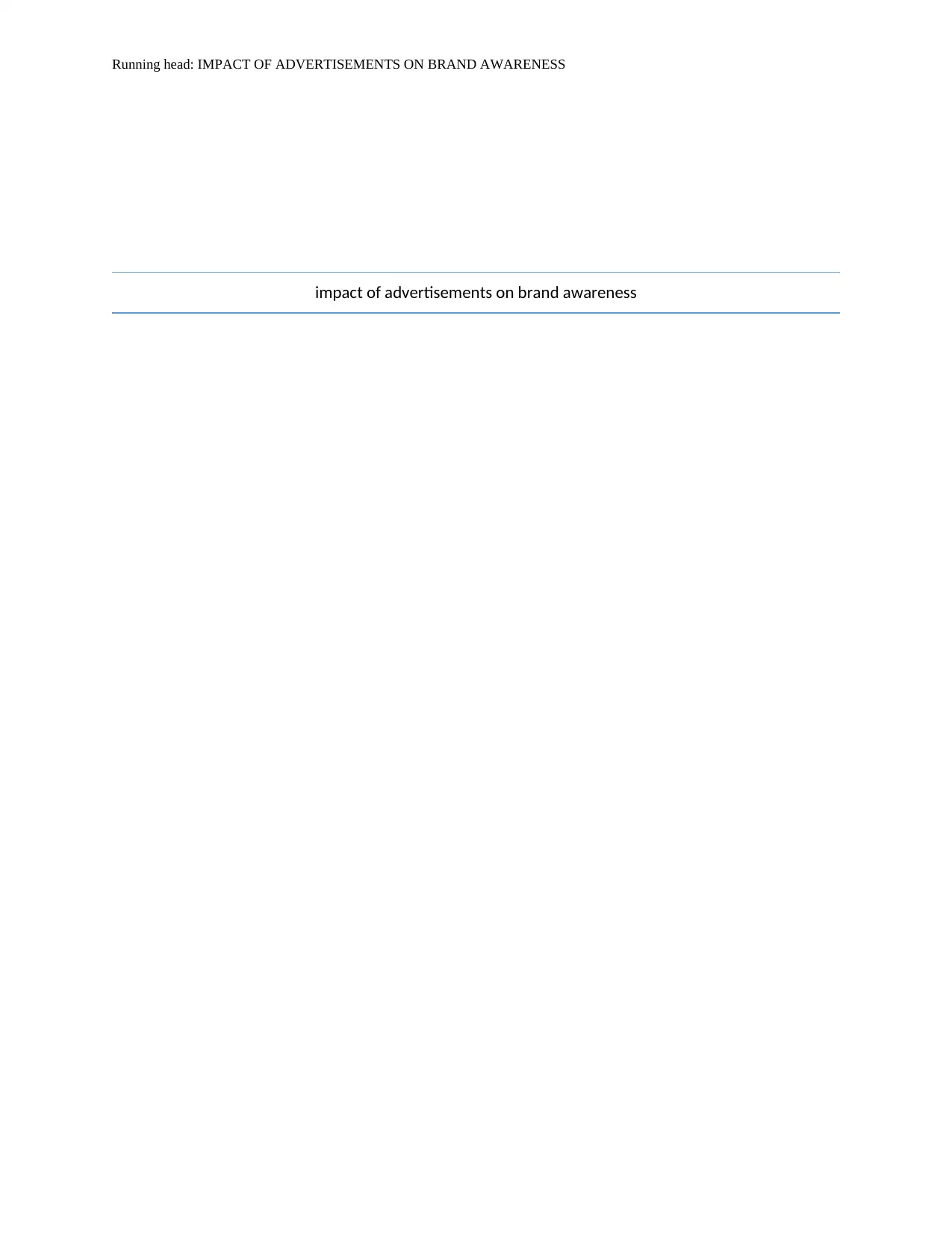
Running head: IMPACT OF ADVERTISEMENTS ON BRAND AWARENESS
impact of advertisements on brand awareness
impact of advertisements on brand awareness
Paraphrase This Document
Need a fresh take? Get an instant paraphrase of this document with our AI Paraphraser
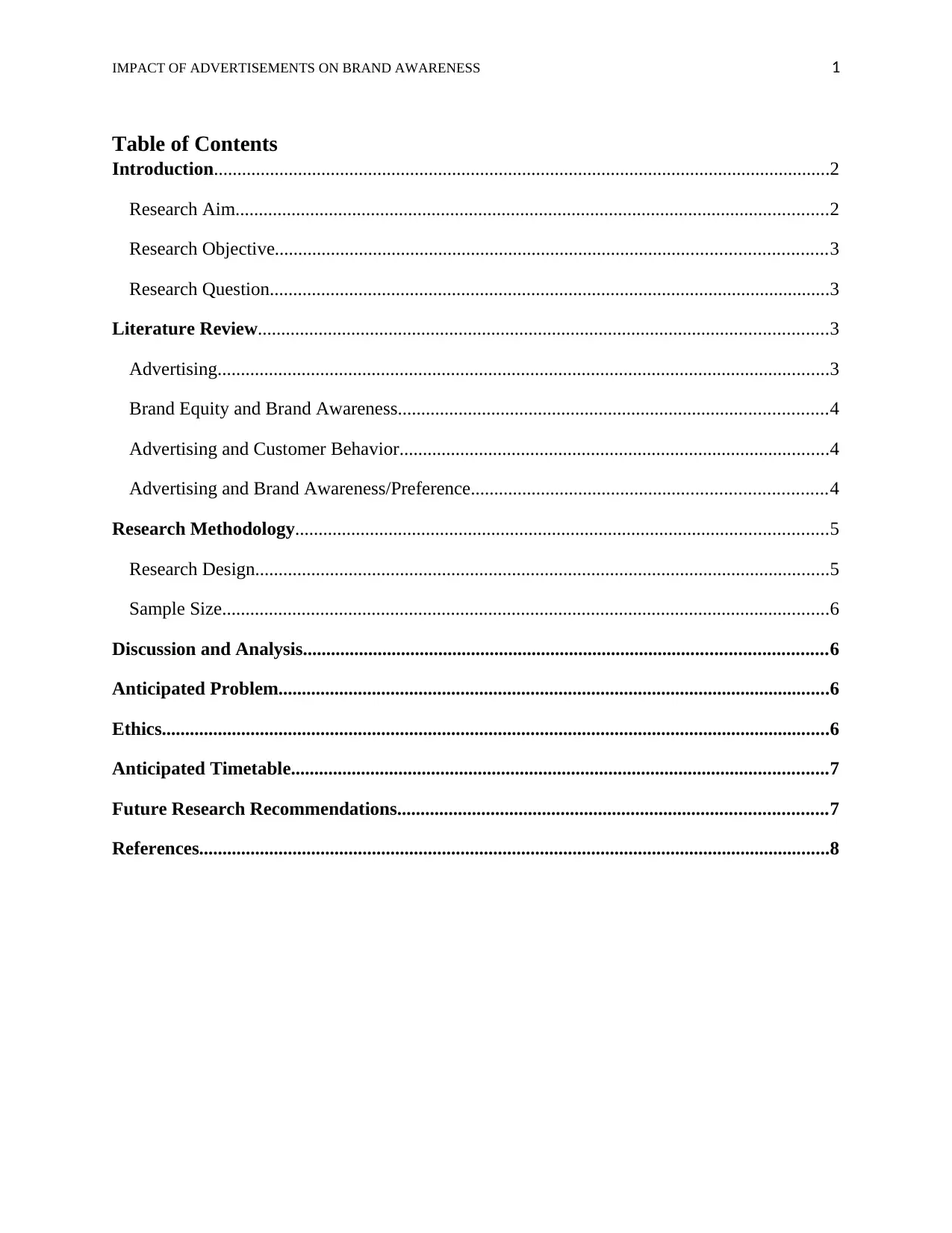
IMPACT OF ADVERTISEMENTS ON BRAND AWARENESS 1
Table of Contents
Introduction....................................................................................................................................2
Research Aim...............................................................................................................................2
Research Objective......................................................................................................................3
Research Question........................................................................................................................3
Literature Review..........................................................................................................................3
Advertising...................................................................................................................................3
Brand Equity and Brand Awareness............................................................................................4
Advertising and Customer Behavior............................................................................................4
Advertising and Brand Awareness/Preference............................................................................4
Research Methodology..................................................................................................................5
Research Design...........................................................................................................................5
Sample Size..................................................................................................................................6
Discussion and Analysis................................................................................................................6
Anticipated Problem......................................................................................................................6
Ethics...............................................................................................................................................6
Anticipated Timetable...................................................................................................................7
Future Research Recommendations............................................................................................7
References.......................................................................................................................................8
Table of Contents
Introduction....................................................................................................................................2
Research Aim...............................................................................................................................2
Research Objective......................................................................................................................3
Research Question........................................................................................................................3
Literature Review..........................................................................................................................3
Advertising...................................................................................................................................3
Brand Equity and Brand Awareness............................................................................................4
Advertising and Customer Behavior............................................................................................4
Advertising and Brand Awareness/Preference............................................................................4
Research Methodology..................................................................................................................5
Research Design...........................................................................................................................5
Sample Size..................................................................................................................................6
Discussion and Analysis................................................................................................................6
Anticipated Problem......................................................................................................................6
Ethics...............................................................................................................................................6
Anticipated Timetable...................................................................................................................7
Future Research Recommendations............................................................................................7
References.......................................................................................................................................8
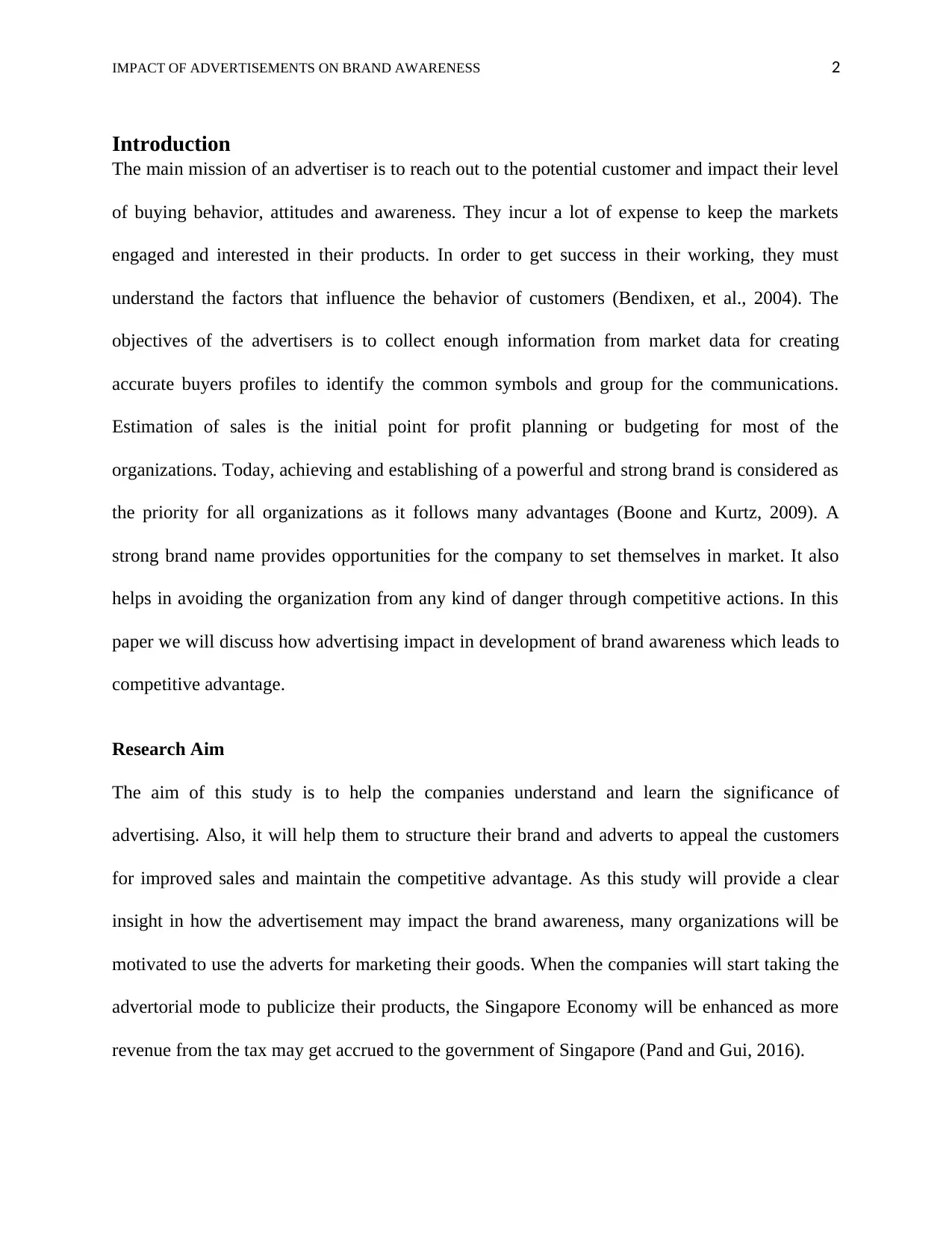
IMPACT OF ADVERTISEMENTS ON BRAND AWARENESS 2
Introduction
The main mission of an advertiser is to reach out to the potential customer and impact their level
of buying behavior, attitudes and awareness. They incur a lot of expense to keep the markets
engaged and interested in their products. In order to get success in their working, they must
understand the factors that influence the behavior of customers (Bendixen, et al., 2004). The
objectives of the advertisers is to collect enough information from market data for creating
accurate buyers profiles to identify the common symbols and group for the communications.
Estimation of sales is the initial point for profit planning or budgeting for most of the
organizations. Today, achieving and establishing of a powerful and strong brand is considered as
the priority for all organizations as it follows many advantages (Boone and Kurtz, 2009). A
strong brand name provides opportunities for the company to set themselves in market. It also
helps in avoiding the organization from any kind of danger through competitive actions. In this
paper we will discuss how advertising impact in development of brand awareness which leads to
competitive advantage.
Research Aim
The aim of this study is to help the companies understand and learn the significance of
advertising. Also, it will help them to structure their brand and adverts to appeal the customers
for improved sales and maintain the competitive advantage. As this study will provide a clear
insight in how the advertisement may impact the brand awareness, many organizations will be
motivated to use the adverts for marketing their goods. When the companies will start taking the
advertorial mode to publicize their products, the Singapore Economy will be enhanced as more
revenue from the tax may get accrued to the government of Singapore (Pand and Gui, 2016).
Introduction
The main mission of an advertiser is to reach out to the potential customer and impact their level
of buying behavior, attitudes and awareness. They incur a lot of expense to keep the markets
engaged and interested in their products. In order to get success in their working, they must
understand the factors that influence the behavior of customers (Bendixen, et al., 2004). The
objectives of the advertisers is to collect enough information from market data for creating
accurate buyers profiles to identify the common symbols and group for the communications.
Estimation of sales is the initial point for profit planning or budgeting for most of the
organizations. Today, achieving and establishing of a powerful and strong brand is considered as
the priority for all organizations as it follows many advantages (Boone and Kurtz, 2009). A
strong brand name provides opportunities for the company to set themselves in market. It also
helps in avoiding the organization from any kind of danger through competitive actions. In this
paper we will discuss how advertising impact in development of brand awareness which leads to
competitive advantage.
Research Aim
The aim of this study is to help the companies understand and learn the significance of
advertising. Also, it will help them to structure their brand and adverts to appeal the customers
for improved sales and maintain the competitive advantage. As this study will provide a clear
insight in how the advertisement may impact the brand awareness, many organizations will be
motivated to use the adverts for marketing their goods. When the companies will start taking the
advertorial mode to publicize their products, the Singapore Economy will be enhanced as more
revenue from the tax may get accrued to the government of Singapore (Pand and Gui, 2016).
⊘ This is a preview!⊘
Do you want full access?
Subscribe today to unlock all pages.

Trusted by 1+ million students worldwide
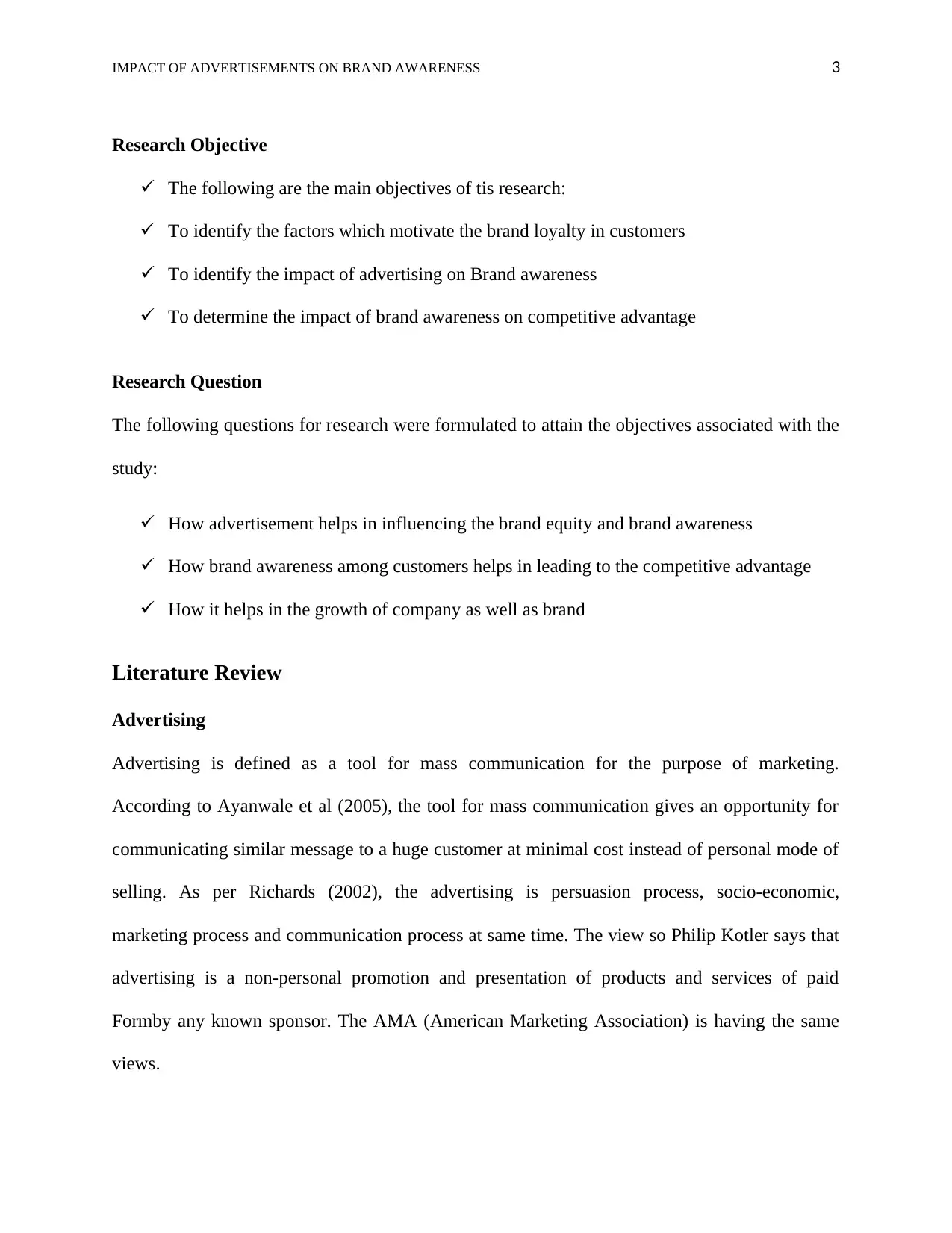
IMPACT OF ADVERTISEMENTS ON BRAND AWARENESS 3
Research Objective
The following are the main objectives of tis research:
To identify the factors which motivate the brand loyalty in customers
To identify the impact of advertising on Brand awareness
To determine the impact of brand awareness on competitive advantage
Research Question
The following questions for research were formulated to attain the objectives associated with the
study:
How advertisement helps in influencing the brand equity and brand awareness
How brand awareness among customers helps in leading to the competitive advantage
How it helps in the growth of company as well as brand
Literature Review
Advertising
Advertising is defined as a tool for mass communication for the purpose of marketing.
According to Ayanwale et al (2005), the tool for mass communication gives an opportunity for
communicating similar message to a huge customer at minimal cost instead of personal mode of
selling. As per Richards (2002), the advertising is persuasion process, socio-economic,
marketing process and communication process at same time. The view so Philip Kotler says that
advertising is a non-personal promotion and presentation of products and services of paid
Formby any known sponsor. The AMA (American Marketing Association) is having the same
views.
Research Objective
The following are the main objectives of tis research:
To identify the factors which motivate the brand loyalty in customers
To identify the impact of advertising on Brand awareness
To determine the impact of brand awareness on competitive advantage
Research Question
The following questions for research were formulated to attain the objectives associated with the
study:
How advertisement helps in influencing the brand equity and brand awareness
How brand awareness among customers helps in leading to the competitive advantage
How it helps in the growth of company as well as brand
Literature Review
Advertising
Advertising is defined as a tool for mass communication for the purpose of marketing.
According to Ayanwale et al (2005), the tool for mass communication gives an opportunity for
communicating similar message to a huge customer at minimal cost instead of personal mode of
selling. As per Richards (2002), the advertising is persuasion process, socio-economic,
marketing process and communication process at same time. The view so Philip Kotler says that
advertising is a non-personal promotion and presentation of products and services of paid
Formby any known sponsor. The AMA (American Marketing Association) is having the same
views.
Paraphrase This Document
Need a fresh take? Get an instant paraphrase of this document with our AI Paraphraser

IMPACT OF ADVERTISEMENTS ON BRAND AWARENESS 4
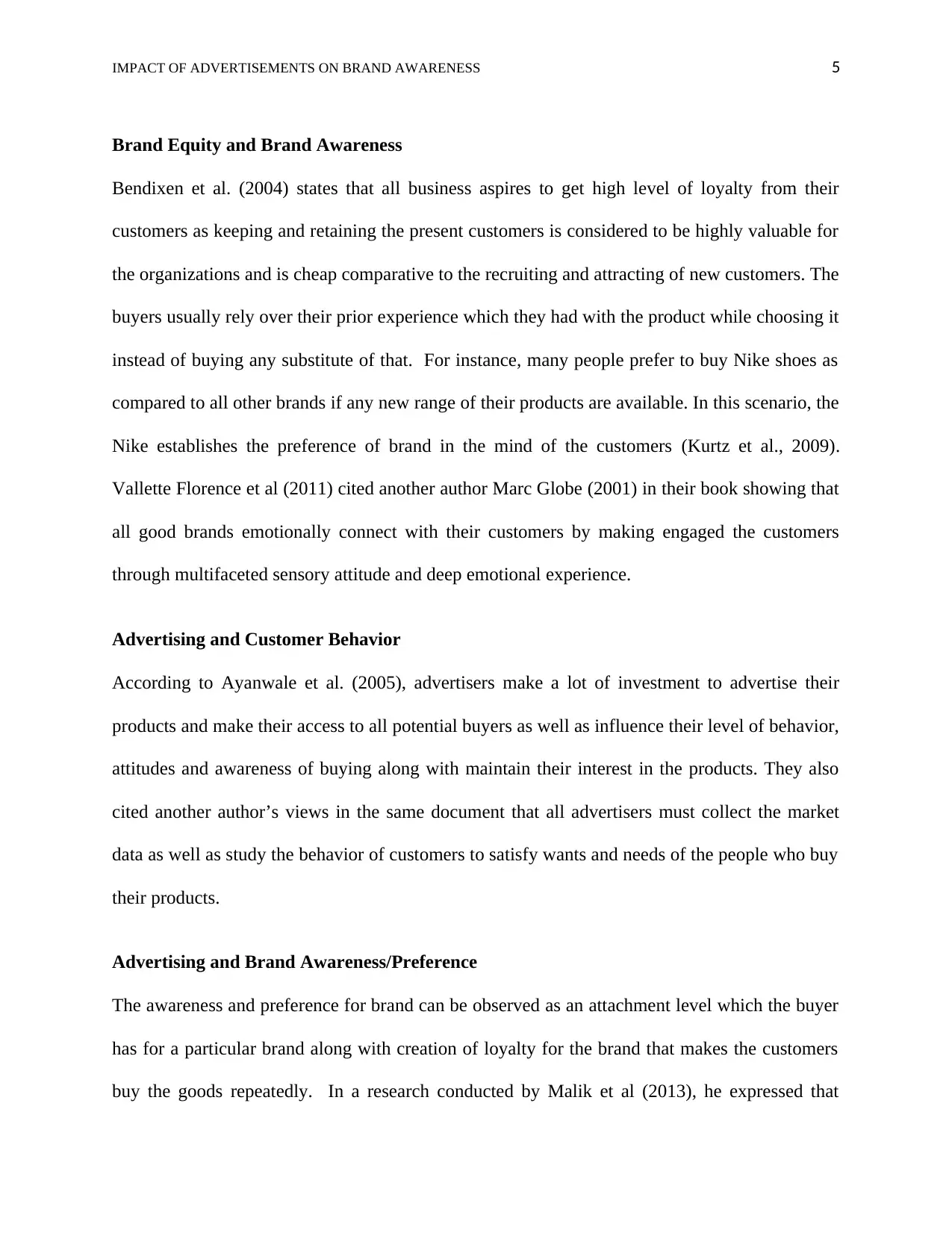
IMPACT OF ADVERTISEMENTS ON BRAND AWARENESS 5
Brand Equity and Brand Awareness
Bendixen et al. (2004) states that all business aspires to get high level of loyalty from their
customers as keeping and retaining the present customers is considered to be highly valuable for
the organizations and is cheap comparative to the recruiting and attracting of new customers. The
buyers usually rely over their prior experience which they had with the product while choosing it
instead of buying any substitute of that. For instance, many people prefer to buy Nike shoes as
compared to all other brands if any new range of their products are available. In this scenario, the
Nike establishes the preference of brand in the mind of the customers (Kurtz et al., 2009).
Vallette Florence et al (2011) cited another author Marc Globe (2001) in their book showing that
all good brands emotionally connect with their customers by making engaged the customers
through multifaceted sensory attitude and deep emotional experience.
Advertising and Customer Behavior
According to Ayanwale et al. (2005), advertisers make a lot of investment to advertise their
products and make their access to all potential buyers as well as influence their level of behavior,
attitudes and awareness of buying along with maintain their interest in the products. They also
cited another author’s views in the same document that all advertisers must collect the market
data as well as study the behavior of customers to satisfy wants and needs of the people who buy
their products.
Advertising and Brand Awareness/Preference
The awareness and preference for brand can be observed as an attachment level which the buyer
has for a particular brand along with creation of loyalty for the brand that makes the customers
buy the goods repeatedly. In a research conducted by Malik et al (2013), he expressed that
Brand Equity and Brand Awareness
Bendixen et al. (2004) states that all business aspires to get high level of loyalty from their
customers as keeping and retaining the present customers is considered to be highly valuable for
the organizations and is cheap comparative to the recruiting and attracting of new customers. The
buyers usually rely over their prior experience which they had with the product while choosing it
instead of buying any substitute of that. For instance, many people prefer to buy Nike shoes as
compared to all other brands if any new range of their products are available. In this scenario, the
Nike establishes the preference of brand in the mind of the customers (Kurtz et al., 2009).
Vallette Florence et al (2011) cited another author Marc Globe (2001) in their book showing that
all good brands emotionally connect with their customers by making engaged the customers
through multifaceted sensory attitude and deep emotional experience.
Advertising and Customer Behavior
According to Ayanwale et al. (2005), advertisers make a lot of investment to advertise their
products and make their access to all potential buyers as well as influence their level of behavior,
attitudes and awareness of buying along with maintain their interest in the products. They also
cited another author’s views in the same document that all advertisers must collect the market
data as well as study the behavior of customers to satisfy wants and needs of the people who buy
their products.
Advertising and Brand Awareness/Preference
The awareness and preference for brand can be observed as an attachment level which the buyer
has for a particular brand along with creation of loyalty for the brand that makes the customers
buy the goods repeatedly. In a research conducted by Malik et al (2013), he expressed that
⊘ This is a preview!⊘
Do you want full access?
Subscribe today to unlock all pages.

Trusted by 1+ million students worldwide
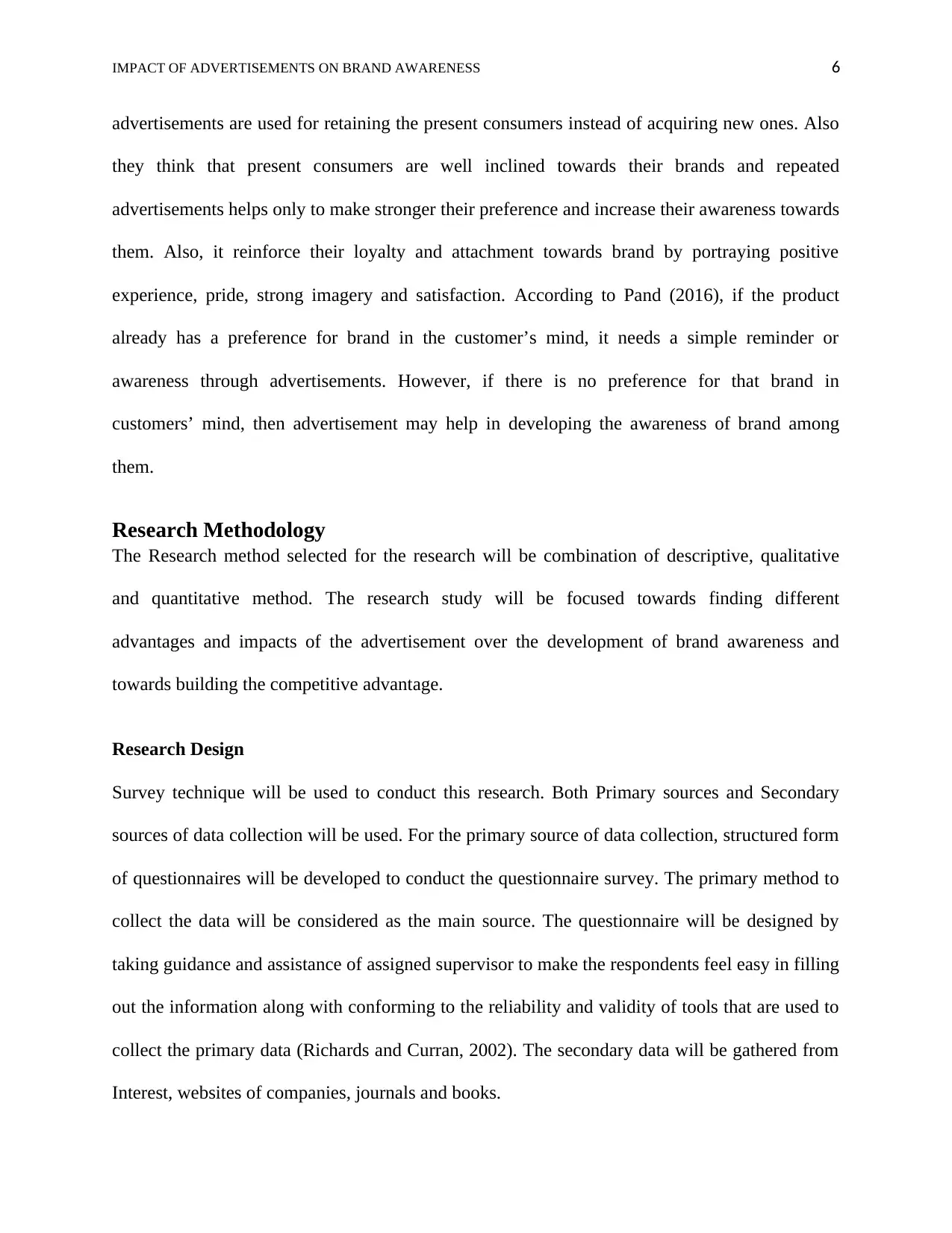
IMPACT OF ADVERTISEMENTS ON BRAND AWARENESS 6
advertisements are used for retaining the present consumers instead of acquiring new ones. Also
they think that present consumers are well inclined towards their brands and repeated
advertisements helps only to make stronger their preference and increase their awareness towards
them. Also, it reinforce their loyalty and attachment towards brand by portraying positive
experience, pride, strong imagery and satisfaction. According to Pand (2016), if the product
already has a preference for brand in the customer’s mind, it needs a simple reminder or
awareness through advertisements. However, if there is no preference for that brand in
customers’ mind, then advertisement may help in developing the awareness of brand among
them.
Research Methodology
The Research method selected for the research will be combination of descriptive, qualitative
and quantitative method. The research study will be focused towards finding different
advantages and impacts of the advertisement over the development of brand awareness and
towards building the competitive advantage.
Research Design
Survey technique will be used to conduct this research. Both Primary sources and Secondary
sources of data collection will be used. For the primary source of data collection, structured form
of questionnaires will be developed to conduct the questionnaire survey. The primary method to
collect the data will be considered as the main source. The questionnaire will be designed by
taking guidance and assistance of assigned supervisor to make the respondents feel easy in filling
out the information along with conforming to the reliability and validity of tools that are used to
collect the primary data (Richards and Curran, 2002). The secondary data will be gathered from
Interest, websites of companies, journals and books.
advertisements are used for retaining the present consumers instead of acquiring new ones. Also
they think that present consumers are well inclined towards their brands and repeated
advertisements helps only to make stronger their preference and increase their awareness towards
them. Also, it reinforce their loyalty and attachment towards brand by portraying positive
experience, pride, strong imagery and satisfaction. According to Pand (2016), if the product
already has a preference for brand in the customer’s mind, it needs a simple reminder or
awareness through advertisements. However, if there is no preference for that brand in
customers’ mind, then advertisement may help in developing the awareness of brand among
them.
Research Methodology
The Research method selected for the research will be combination of descriptive, qualitative
and quantitative method. The research study will be focused towards finding different
advantages and impacts of the advertisement over the development of brand awareness and
towards building the competitive advantage.
Research Design
Survey technique will be used to conduct this research. Both Primary sources and Secondary
sources of data collection will be used. For the primary source of data collection, structured form
of questionnaires will be developed to conduct the questionnaire survey. The primary method to
collect the data will be considered as the main source. The questionnaire will be designed by
taking guidance and assistance of assigned supervisor to make the respondents feel easy in filling
out the information along with conforming to the reliability and validity of tools that are used to
collect the primary data (Richards and Curran, 2002). The secondary data will be gathered from
Interest, websites of companies, journals and books.
Paraphrase This Document
Need a fresh take? Get an instant paraphrase of this document with our AI Paraphraser
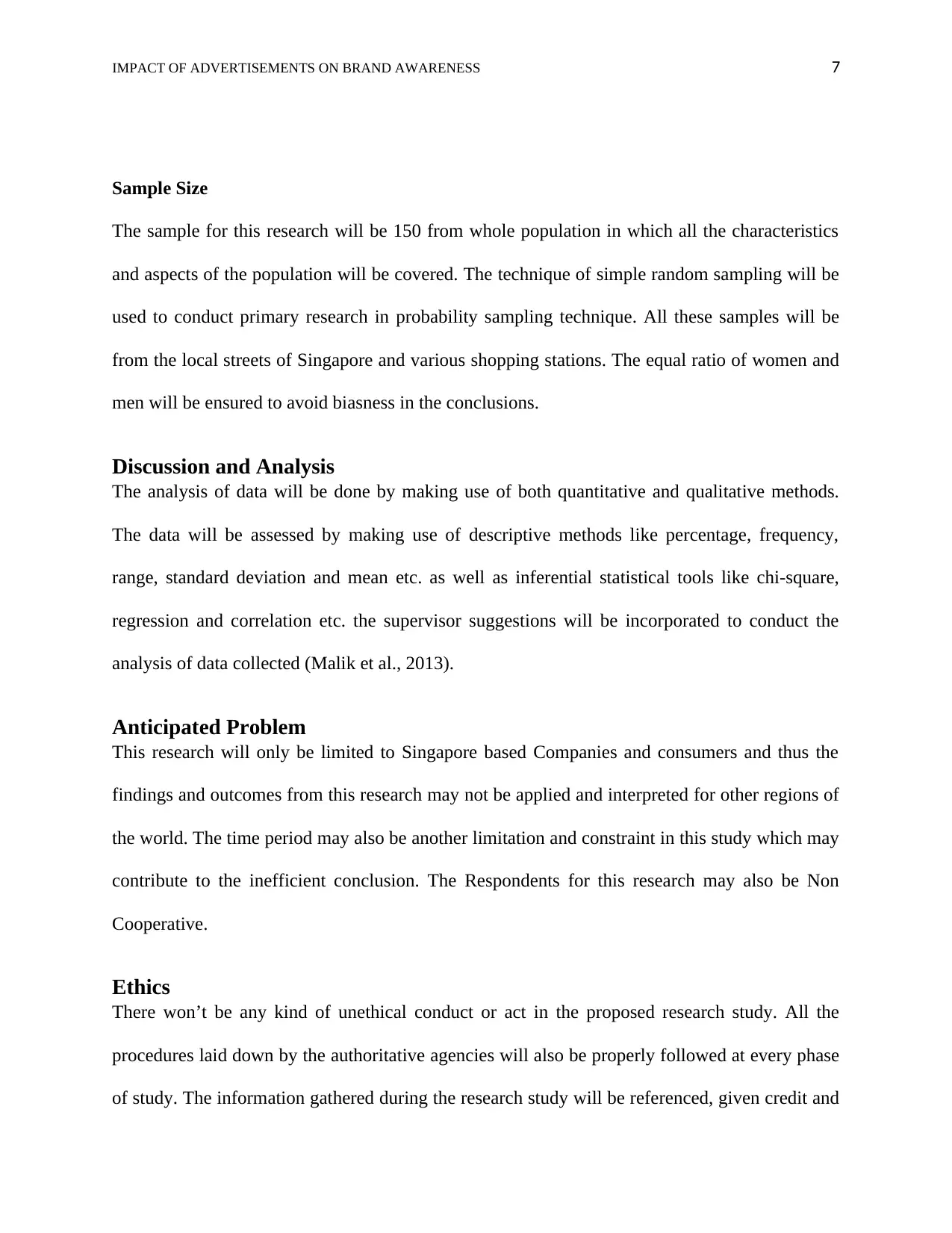
IMPACT OF ADVERTISEMENTS ON BRAND AWARENESS 7
Sample Size
The sample for this research will be 150 from whole population in which all the characteristics
and aspects of the population will be covered. The technique of simple random sampling will be
used to conduct primary research in probability sampling technique. All these samples will be
from the local streets of Singapore and various shopping stations. The equal ratio of women and
men will be ensured to avoid biasness in the conclusions.
Discussion and Analysis
The analysis of data will be done by making use of both quantitative and qualitative methods.
The data will be assessed by making use of descriptive methods like percentage, frequency,
range, standard deviation and mean etc. as well as inferential statistical tools like chi-square,
regression and correlation etc. the supervisor suggestions will be incorporated to conduct the
analysis of data collected (Malik et al., 2013).
Anticipated Problem
This research will only be limited to Singapore based Companies and consumers and thus the
findings and outcomes from this research may not be applied and interpreted for other regions of
the world. The time period may also be another limitation and constraint in this study which may
contribute to the inefficient conclusion. The Respondents for this research may also be Non
Cooperative.
Ethics
There won’t be any kind of unethical conduct or act in the proposed research study. All the
procedures laid down by the authoritative agencies will also be properly followed at every phase
of study. The information gathered during the research study will be referenced, given credit and
Sample Size
The sample for this research will be 150 from whole population in which all the characteristics
and aspects of the population will be covered. The technique of simple random sampling will be
used to conduct primary research in probability sampling technique. All these samples will be
from the local streets of Singapore and various shopping stations. The equal ratio of women and
men will be ensured to avoid biasness in the conclusions.
Discussion and Analysis
The analysis of data will be done by making use of both quantitative and qualitative methods.
The data will be assessed by making use of descriptive methods like percentage, frequency,
range, standard deviation and mean etc. as well as inferential statistical tools like chi-square,
regression and correlation etc. the supervisor suggestions will be incorporated to conduct the
analysis of data collected (Malik et al., 2013).
Anticipated Problem
This research will only be limited to Singapore based Companies and consumers and thus the
findings and outcomes from this research may not be applied and interpreted for other regions of
the world. The time period may also be another limitation and constraint in this study which may
contribute to the inefficient conclusion. The Respondents for this research may also be Non
Cooperative.
Ethics
There won’t be any kind of unethical conduct or act in the proposed research study. All the
procedures laid down by the authoritative agencies will also be properly followed at every phase
of study. The information gathered during the research study will be referenced, given credit and
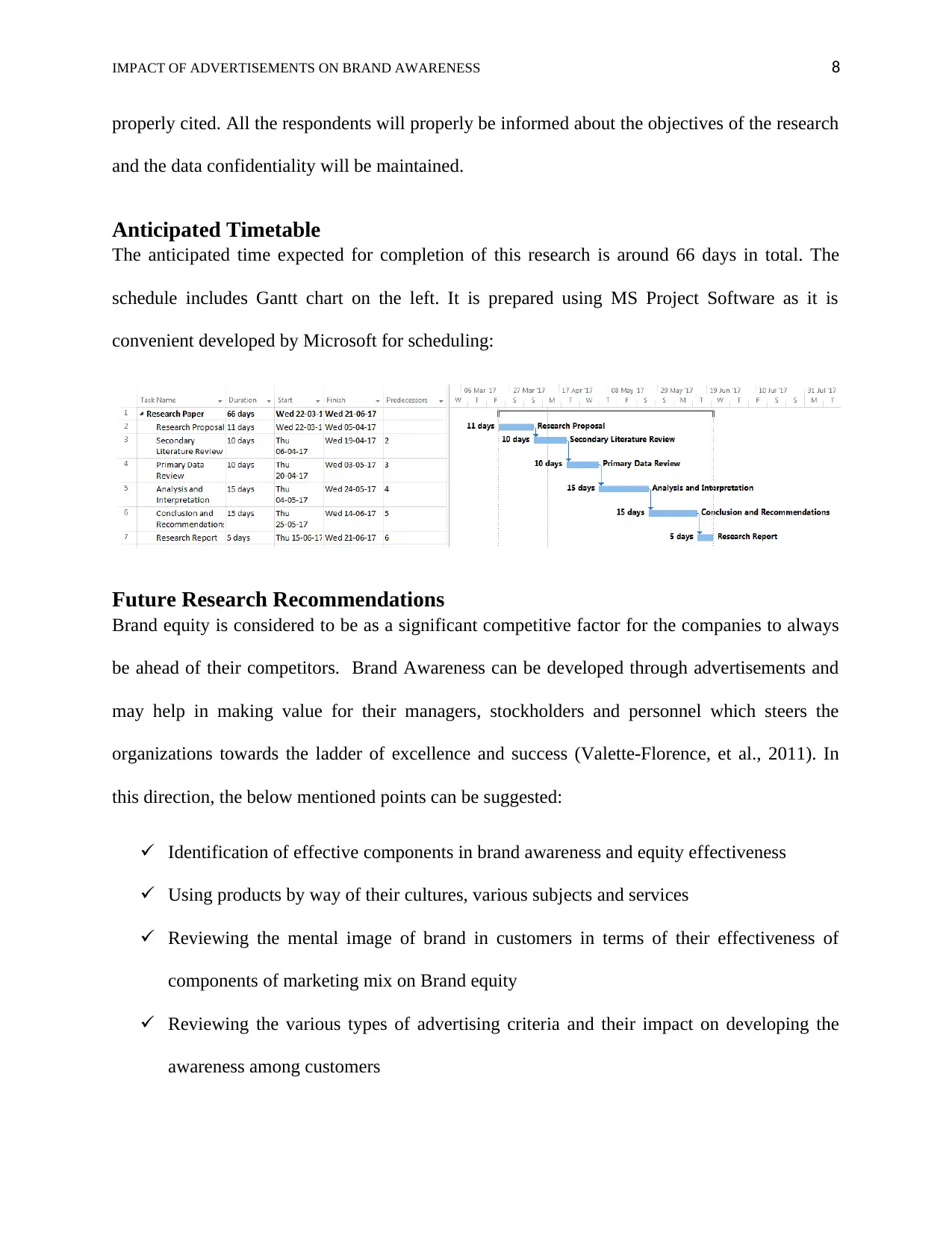
IMPACT OF ADVERTISEMENTS ON BRAND AWARENESS 8
properly cited. All the respondents will properly be informed about the objectives of the research
and the data confidentiality will be maintained.
Anticipated Timetable
The anticipated time expected for completion of this research is around 66 days in total. The
schedule includes Gantt chart on the left. It is prepared using MS Project Software as it is
convenient developed by Microsoft for scheduling:
Future Research Recommendations
Brand equity is considered to be as a significant competitive factor for the companies to always
be ahead of their competitors. Brand Awareness can be developed through advertisements and
may help in making value for their managers, stockholders and personnel which steers the
organizations towards the ladder of excellence and success (Valette-Florence, et al., 2011). In
this direction, the below mentioned points can be suggested:
Identification of effective components in brand awareness and equity effectiveness
Using products by way of their cultures, various subjects and services
Reviewing the mental image of brand in customers in terms of their effectiveness of
components of marketing mix on Brand equity
Reviewing the various types of advertising criteria and their impact on developing the
awareness among customers
properly cited. All the respondents will properly be informed about the objectives of the research
and the data confidentiality will be maintained.
Anticipated Timetable
The anticipated time expected for completion of this research is around 66 days in total. The
schedule includes Gantt chart on the left. It is prepared using MS Project Software as it is
convenient developed by Microsoft for scheduling:
Future Research Recommendations
Brand equity is considered to be as a significant competitive factor for the companies to always
be ahead of their competitors. Brand Awareness can be developed through advertisements and
may help in making value for their managers, stockholders and personnel which steers the
organizations towards the ladder of excellence and success (Valette-Florence, et al., 2011). In
this direction, the below mentioned points can be suggested:
Identification of effective components in brand awareness and equity effectiveness
Using products by way of their cultures, various subjects and services
Reviewing the mental image of brand in customers in terms of their effectiveness of
components of marketing mix on Brand equity
Reviewing the various types of advertising criteria and their impact on developing the
awareness among customers
⊘ This is a preview!⊘
Do you want full access?
Subscribe today to unlock all pages.

Trusted by 1+ million students worldwide
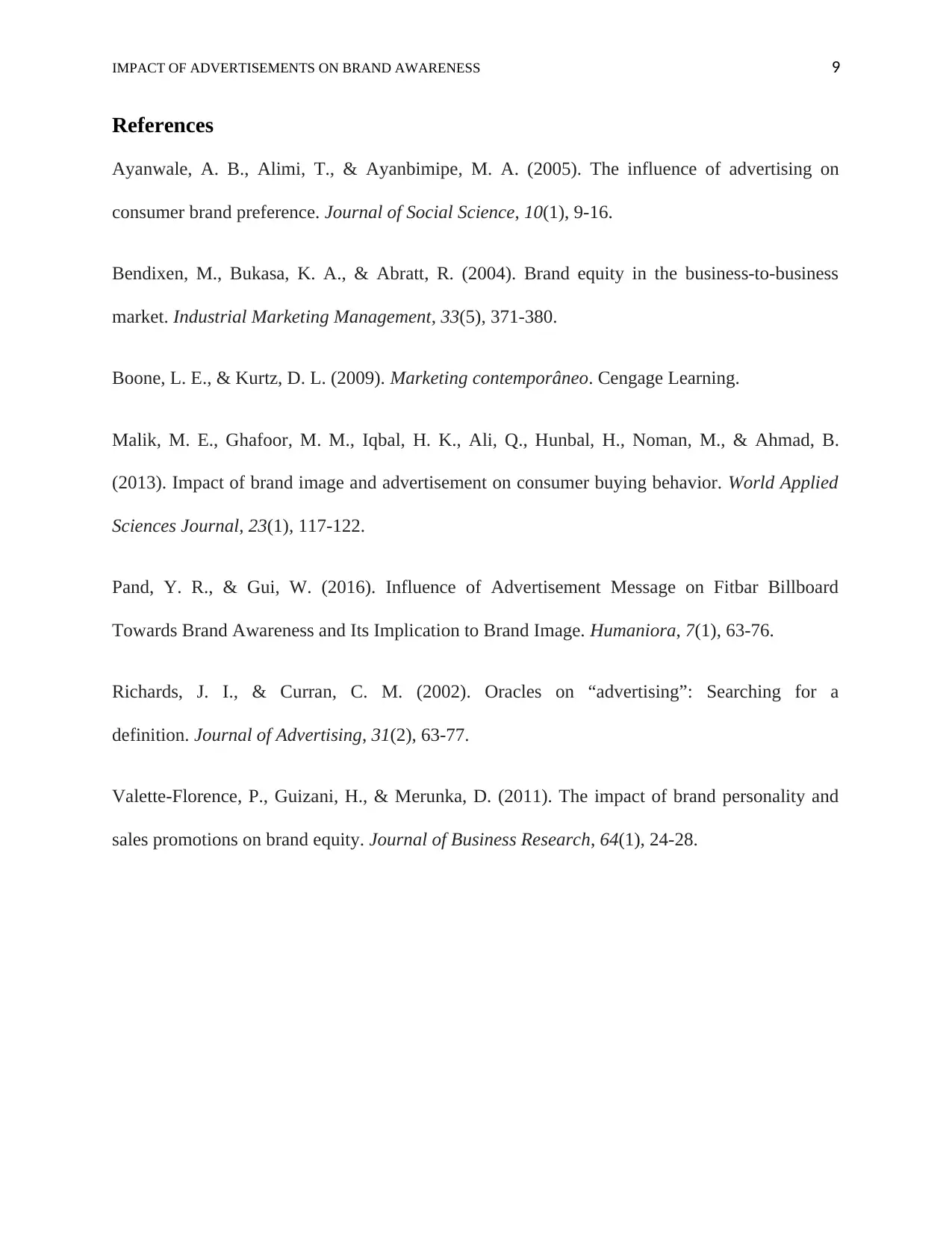
IMPACT OF ADVERTISEMENTS ON BRAND AWARENESS 9
References
Ayanwale, A. B., Alimi, T., & Ayanbimipe, M. A. (2005). The influence of advertising on
consumer brand preference. Journal of Social Science, 10(1), 9-16.
Bendixen, M., Bukasa, K. A., & Abratt, R. (2004). Brand equity in the business-to-business
market. Industrial Marketing Management, 33(5), 371-380.
Boone, L. E., & Kurtz, D. L. (2009). Marketing contemporâneo. Cengage Learning.
Malik, M. E., Ghafoor, M. M., Iqbal, H. K., Ali, Q., Hunbal, H., Noman, M., & Ahmad, B.
(2013). Impact of brand image and advertisement on consumer buying behavior. World Applied
Sciences Journal, 23(1), 117-122.
Pand, Y. R., & Gui, W. (2016). Influence of Advertisement Message on Fitbar Billboard
Towards Brand Awareness and Its Implication to Brand Image. Humaniora, 7(1), 63-76.
Richards, J. I., & Curran, C. M. (2002). Oracles on “advertising”: Searching for a
definition. Journal of Advertising, 31(2), 63-77.
Valette-Florence, P., Guizani, H., & Merunka, D. (2011). The impact of brand personality and
sales promotions on brand equity. Journal of Business Research, 64(1), 24-28.
References
Ayanwale, A. B., Alimi, T., & Ayanbimipe, M. A. (2005). The influence of advertising on
consumer brand preference. Journal of Social Science, 10(1), 9-16.
Bendixen, M., Bukasa, K. A., & Abratt, R. (2004). Brand equity in the business-to-business
market. Industrial Marketing Management, 33(5), 371-380.
Boone, L. E., & Kurtz, D. L. (2009). Marketing contemporâneo. Cengage Learning.
Malik, M. E., Ghafoor, M. M., Iqbal, H. K., Ali, Q., Hunbal, H., Noman, M., & Ahmad, B.
(2013). Impact of brand image and advertisement on consumer buying behavior. World Applied
Sciences Journal, 23(1), 117-122.
Pand, Y. R., & Gui, W. (2016). Influence of Advertisement Message on Fitbar Billboard
Towards Brand Awareness and Its Implication to Brand Image. Humaniora, 7(1), 63-76.
Richards, J. I., & Curran, C. M. (2002). Oracles on “advertising”: Searching for a
definition. Journal of Advertising, 31(2), 63-77.
Valette-Florence, P., Guizani, H., & Merunka, D. (2011). The impact of brand personality and
sales promotions on brand equity. Journal of Business Research, 64(1), 24-28.
1 out of 10
Related Documents
Your All-in-One AI-Powered Toolkit for Academic Success.
+13062052269
info@desklib.com
Available 24*7 on WhatsApp / Email
![[object Object]](/_next/static/media/star-bottom.7253800d.svg)
Unlock your academic potential
Copyright © 2020–2025 A2Z Services. All Rights Reserved. Developed and managed by ZUCOL.





